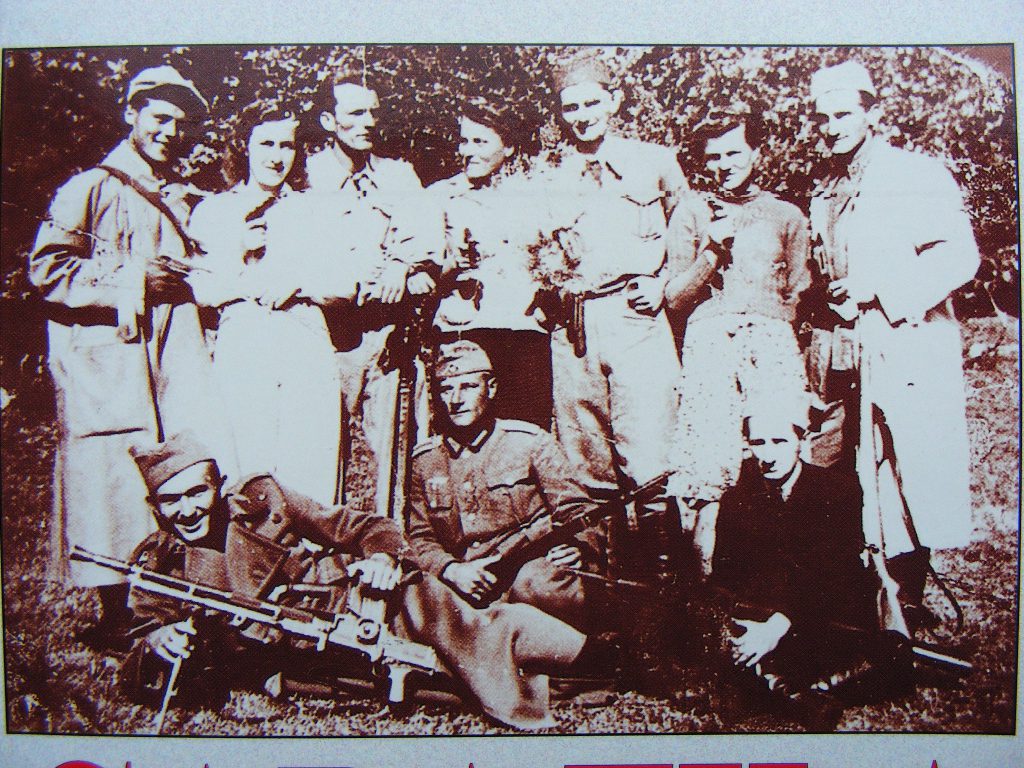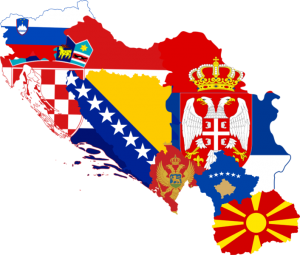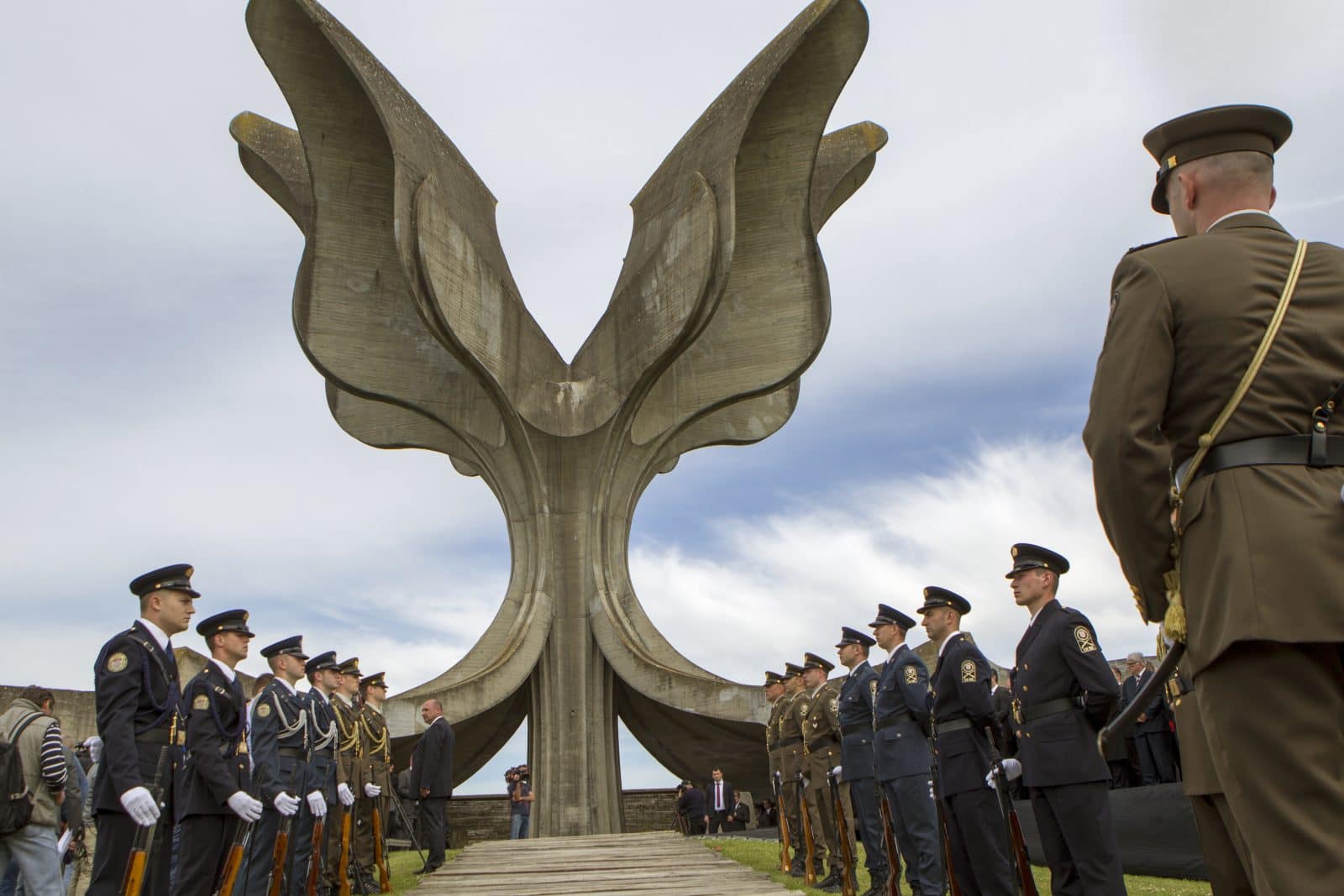
Views: 755
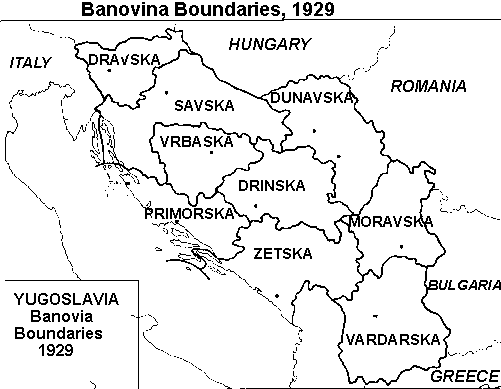 Boundaries of the Banovina districts of the Kingdom of Yugoslavia, 1929-1941
Boundaries of the Banovina districts of the Kingdom of Yugoslavia, 1929-1941
Regardless of the reached agreement on the Croatian ethnopolitical autonomy in Yugoslavia, the (Roman Catholic) Croatian traditional and historical animosity and even a hate against the (Christian Orthodox) Serbs remained extremely strong – a fact which both Adolf Hitler and Benito Mussolini knew very well to exploit in the coming events of the 1941 April War against the Kingdom of Yugoslavia.

Originally, Yugoslavia signed the pact with the Axis Powers on March 25th, 1941 but due to the British plot, the military putsch was organized in Belgrade two days later followed by the forming of a new (pro-British) Government – a fact which ultimately forced Hitler to decide to occupy both Yugoslavia and Greece (the “Operation Marita”) before launching the “Operation Barbarossa” against the USSR. Germany and its allies considered the 1941 Belgrade April Putsch as a direct challenge, and, therefore, the war was simply inevitable. A capital of Yugoslavia – Belgrade was heavily bombed by the Luftwaffe in the early morning of April 6th, 1941 (the Orthodox Easter Day), and at the same time the German, the Italian, the Hungarian, and the Bulgarian land forces entered Yugoslavia from all possible sides. The Axis Power’s war against the Kingdom of Yugoslavia was short and effective – the country was occupied after only 12 days of resistance (April 6‒18th, 1941) without getting any military support from the United Kingdom.
The partition of Yugoslavia after the 1941 April War was immediate and brutal. Slovenia was partitioned between Italy, Hungary and Germany, enlarged Montenegro under the Italian protectorate was established, the largest part of Kosovo-Metochia and West Macedonia went to a Greater Albania with the capital in Tirana, Bulgaria occupied East and Central Vardar Macedonia, Serbia’s province of Vojvodina was divided between Croatia, Hungary, and Germany while a small Serbia was put under direct German military supervision. However, the biggest winners after the destruction of Yugoslavia in April 1941 became the Croats as the Ustashi established a Nazi-fascist puppet Independent State of Croatia which included whole Bosnia-Herzegovina, Croatia proper, Slavonia, Srem, and biggest portion of Dalmatia as a smaller one occupied Italy according to the secret 1915 London Agreement with the Ententé. However, Croatia became additionally enlarged after the capitulation of Italy in September 1943 as all East Adriatic Italian possessions were transferred to Croatia which never was bigger in history as it was in 1943‒1945.
At any case, the most important post-April War creation on the territory of ex-Kingdom of Yugoslavia was an Independent State of Croatia that was officially proclaimed on April 10th, 1941. The official name of the state was Neovisna država Hrvatska (the NDH) with capital in Zagreb. It had 6.663.157 inhabitants according to the last pre-war census and covered the territory of 102.725 sq. km.[i] According to the Rome Treaties from May 1941 between Italy and the NDH, the latter gave to its patron Italy Kastav and Sušak with its hinterland, the islands of Krk and Rab, North Dalmatian and parts of Central Dalmatian sea cost, the biggest part of the Adriatic islands and a part of Konavle. Therefore, Italy realized all paragraphs of the secret London Treaty signed between Italy and the Ententé in April 1915.
 Project of a Greater Croatia by the Ustashi movement
Project of a Greater Croatia by the Ustashi movement
As a matter of fact, the fast and comprehensive collapse of the Kingdom of Yugoslavia in 1941 occurred for at least three fundamental reasons:
- The country was not prepared for the war at all especially from the military-technical, logistic and diplomatic points of view.
- The aggressors were much stronger from all military points of view in comparison to Yugoslavia.
- Total Croat treachery during the April War. In fact, only the ethnic Serbs fought the Germans and their allies as it was possible.
As a consequence of the military defeat in April 1941, some 375.000 officers and soldiers of the Yugoslav army, but only of the Serb origin, fell into the Axis hands and became the prisoners of war in Germany. Nevertheless, on the territory of the NDH fanatical Serb-hating Croat Nazi-fascist Ustashi were on the loose, perpetrating appalling massacres which very soon led to the Serb uprising and the loss of de facto control over the large areas.[ii] The brutal military destruction of the Kingdom of Yugoslavia, her occupation followed by the creation of a Greater Croatia (the NDH) and massacres of its Orthodox, Roma and Jewish population were the historical triumph of Vatican and the Roman Catholic separatism.[iii]
As the Independent State of Croatia was functioning like Vatican’s military province at the Balkans, the genocide over the Orthodox Serbs was an order of the day.[iv] Until the end of its existence on May 15th, 1945, the Government of the Independent State of Croatia exterminated around 750.000 Serbs[v] in addition to the Jews and the Roma. The most barbaric and notorious death camp (the “Ninth Circle of Hell”) during WWII in Europe was functioning almost four years, located not so far from Zagreb on the River Sava – Jasenovac in which around 700.000 people have been brutally murdered among them 500.000 ethnic Serbs. One big part of those Serbs who physically survived, was converted into the Roman Catholicism and, subsequently, Croatized or expelled across the River Drina to neighboring Serbia (Serbia accepted around 400.000 Serb refugees from the territory of the Independent State of Croatia during the war). The Croatian Roman Catholic clergy participated directly and openly in this unprecedented genocide which was indirectly blessed by the Archbishop of Croatia Alois Stepinac – the “Archbishop of Genocide”.[vi]
Subsequently, it is not of any surprise that the 32nd US President Th. F. D. Roosevelt (1933−1945) told in fall 1944 that after the war the Croats as a nation did not deserve any right to possess their own national state as they showed to be the animals during the war. For such nation as the Croats were, Roosevelt anticipated international monitoring but not any kind of Croatia. However, after the war, a Croat led the Communist Party of Yugoslavia created even bigger Croatia within Yugoslavia than it was before the war and at the same time reducing Serbia into the borders before the Balkan Wars of 1912−1913. Moreover, the Croats backed by Vatican and Germany continued the NDH’s policy of Serbophobia in the 1990s and, in essence, succeeded to create “Serbenfrei Kroaten” as today in Croatia there are only up to 4 per cents of the Serbs in comparison to 25 per cents in 1940 or 12 per cents in 1990.
 Jasenovac: “Final Solution” of the Serb Question in a Greater Croatia
Jasenovac: “Final Solution” of the Serb Question in a Greater Croatia
The occupation forces of Germany, Italy, Bulgaria, and Hungary presented their occupation and destruction of the Kingdom of Yugoslavia as the “liberation” from a rule of the “Greater Serbian bourgeoisie” and, therefore, the Croat Nazi-fascist Ustashi were allowed to create a “national” state of the Croats encompassing alleged almost total ethnographic and historic lands of the Croats. The Bosnian-Herzegovinian Muslims (today Bosniaks) were officially proclaimed by the Ustashi regime in Zagreb as the “flower of the Croatian nation” and Bosnia-Herzegovina was called as the “heart of Croatia”,[vii] the Montenegrins as the “Red Croats”, and the Slovenes as the “Alpine Croats”. Even formally, the Serbs within the NDH were proclaimed as the “Greek-Eastern Croats” but it did not protect them too much from the pogroms and genocide. The final task of the regime in Zagreb was to “liberate” the territory of the NDH from the Serbs as an ethnic group through genocide, forced expulsion, and forced conversion to the Roman Catholicism.[viii]
During WWII in Yugoslavia, there was a significant resistance movement – the Yugoslav Army in the Fatherland up to the Teheran Conference in 1943 unconditionally supported by London and Washington. The so-called Chetniks were loyal to the Yugoslav royal house (of the Serb origin) fighting for the capitalist parliamentary democratic post-war Yugoslavia reconstructed into three Federal units (Slovenia, Croatia, and Serbia) while their most fervent political opponents – Titoist Partisans, supported an idea of the six Federal republics (Slovenia, Croatia, Bosnia-Herzegovina, Montenegro, Serbia, and Macedonia), command economy, socialism, and one-party system after the war as a pure copy of the Soviet example.
The members of the Royal Yugoslav Army in the Fatherland, known also as the Chetniks of General Dragoljub Draža Mihajlović (1893−1946)[ix] consisted largely of the Serbian pre-war officers and soldiers,[x] as they could vent their wrath on the Croatians and Bosnian-Herzegovinian Muslims (Bosniaks), slaughtering many Ustashi but as well as and Croatian and Bosniak civilians as a matter of retaliation, in return. The Partisans of half Slovenian, half Croat Josip Broz Tito (1892−1980) during the whole war mainly directly or indirectly collaborated with the Nazi-fascist regime in Zagreb[xi] but at the very end of the war exterminated several tens of thousands of the Ustashi in Austria (Bleiburg) for the political security reasons after the war.
During the war, the Partisans were trying as much as possible to avoid open conflicts with the Germans as saving their forces to fight only the Chetniks for the sake of overtaking political power at the end of the war. In other words, the Partisans were fighting the Germans only when they were directly attacked by them – the so-called by the Titoist historiography the “seven offensives” committed by the Germans (in fact, half of them were committed against the Chetniks).
The royalist Chetniks fought under the slogan “For the King and the Fatherland, with faith in God” and their appeal was, in fact, mainly limited to the ethnic Serbs, among whom faithfulness to the (Serb) royal dynasty was principally widespread. The Partisans of the Austro-Hungarian corporal Josip Broz Tito fought to drastically alter both economic and political systems of the country after the war but at the final expense of the Serbs and Serbia. In other words, the nationalisms of all other nationalities in Yugoslavia had to be satisfied before the Serb one. Accordingly, an ultimately Serbophobic national program of the Titoists called for the creation after the war of an artificial national groups from the Serbian ethnonational corpus – the Macedonians, the Montenegrins, and the Muslims (Bosniaks), for the creation of only autonomous provinces within Serbia in the whole country (Vojvodina and Kosovo-Metohija), and finally for the creation of a Greater Croatia as a republic in Yugoslavia to be enlarged by the pre-war East Adriatic Italian territories in addition to South Dalmatia with Dubrovnik. The Communist-led Partisans, in fact, promised both what the Axis Powers already delivered – a „liberation“ from the Serb „oppression“ and a Yugoslav royal house and liberation from the Axis occupation and their „domestic collaborators“. According to their design, the result of such proclaimed „national liberation“ was to be created a Federal and republican Yugoslavia, reconstituted declaratively as „free and common homeland of all of its equal nations and nationalities“ but with small Serbia, a Greater Croatia, and the verification of the genocide over the Serbs committed during the war by the Croats, the Bosniaks, and the Albanians.
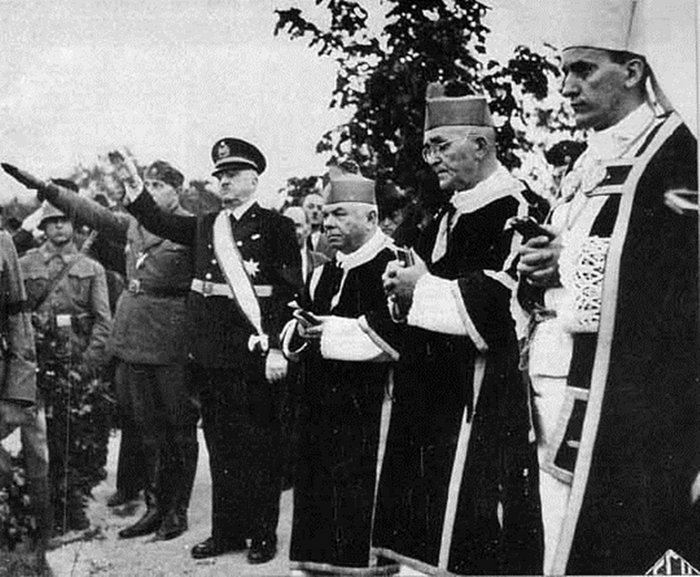 Croatian Archbishop Aloyz Stepinac (far right), Catholic clergy and the Ustashi in Zagreb
Croatian Archbishop Aloyz Stepinac (far right), Catholic clergy and the Ustashi in Zagreb
The ultimate victors of the Yugoslav civil war in 1941‒1945 became Tito’s Partisans who governed Yugoslavia with an iron hand for four decades, while the fundamental losers became the Serbs and especially Serbia. The Serbophobic feelings and activities of their leader are well known to the historians and political analysts.[xii] Nevertheless, the Partisan appeal and projects for post-war Yugoslavia cannot fully account for the Communist victory at the end of the war over their principal political rival – the Chetniks of General Dragoljub Draža Mihailović. In fact, it was the switch of London in military assistance and political recognition after the 1943 Teheran Conference from the royalist Chetniks to the Communist Partisans that enabled the latter, as now the focal British ally in Yugoslavia, to forcibly recruit and arm a significantly larger number of soldiers in comparison to the Chetniks, and finally to won over them in Serbia in October 1944 with a crucial military support by the Red Army.
As a matter of very historical fact, without the crucial British provision of arms, military equipment, and safe island of Vis in the Adriatic Sea for Tito’s headquarters, the Partisans would not have been really capable to survive the Axis military offensives and the Chetnik onslaught in 1943 and 1944 and to occupy during the German withdrawing from the Balkans large territories of Yugoslavia. However, the real reason why the UK changed its Yugoslav policy of support was not because the Partisans were more successful in fighting the Germans (as they have been not attacking them at all) but because the British PM Winston Churchill, a notorious Serbophobe like Tito, did not want that the Serbs (the Chetniks) would win the civil war in Yugoslavia and, therefore, he rather preferred a Croat Josip Broz Tito and his project of a Greater Croatia and reduced Serbia within Yugoslavia after the war.
In the Western historiography, however, exists several misapprehensions on the issue how a Communist Josip Broz Tito and his Partisans took the power at the end of the war and, consequently, established their own (Communist) Government after WWII in Yugoslavia[xiii] without sharing political power with anyone.[xiv]
The first fallacy is that Tito was legally elected in November 1945 as his military forces and political party members controlled the entire political life in Yugoslavia including all kinds of mass media and public propaganda, organized the quasi-elections and finally counted the votes as they wanted. In other words, the November 11th “elections” were a political manifestation of the burlesque.[xv]
 Bosnian-Herzegovinian President in the 1990s Alija Izetbegović was during the WWII a member of Himmler’s established Muslim SS Hanjar Division
Bosnian-Herzegovinian President in the 1990s Alija Izetbegović was during the WWII a member of Himmler’s established Muslim SS Hanjar Division
The second misapprehension is that Tito won the November 11th “elections” because of his immense moral prestige as a leader of the anti-German resistance movement during the war. However, the truth is that his Partisans during the whole war collaborated with the Croat Nazi-fascist Ustashi and even with the Nazi Germans (for example, the 1943 March Agreements in Bosnia). Tito’s Partisans were fighting only the legal Royal Yugoslav Army in the Fatherland but not either Germans or Ustashi for the sake to take power after the war but not to liberate the country as the principal aim.
Probably the biggest error is the claim that Tito’s forces, not the Soviets, liberated Yugoslavia from the German occupation, and that Tito resented Stalin’s attempt to military interfere into the Yugoslav affairs.[xvi] Contrary to such focal error, the fact was that without a crucial and very direct military support (in heavy artillery, tanks, and soldiers) by the Red Army in the fall of 1944, Tito’s Partisans will never occupy either Belgrade or Serbia – the most important part of Yugoslavia. For this military support, Tito personally asked Stalin in Moscow in September 1944.[xvii] Up to that time, the Bretons were sending by air a huge military help to Tito’s forces in 1943 and 1944 and only due to this help combined with the crucial Soviet support in October 1944 when the Red Army entered Serbia from Romania, Tito succeeded to defeat the Royal Yugoslav Army in the Fatherland. We also cannot forget that it was only with the support of the Soviet troops that the Titoists succeeded to take over the northern territories of Yugoslavia held by the German army and the Ustashi until May 1945. In other words, without both the Soviet military intervention and the British military assistance, the Yugoslav Partisans would have not been able to occupy Yugoslavia and to overtake political power.
Finally, Josip Broz Tito did not enjoy any significant moral or patriotic support in the most populated land of Yugoslavia – Serbia during the whole war or after it. In Serbia Tito’s occupation forces up to November 1945 committed terrible crimes[xviii] as they, according to Tito’s order in September 1944, treated Serbia as an enemy country to be severely punished for her anti-Partisan and anti-Communist feelings and actions during the war.
sotirovic1967@gmail.com
© Vladislav B. Sotirovic 2019
Endnotes:
[i] Stjepan Srkulj, Josip Lučić, Hrvatska povijest u dvadeset pet karata. Prošireno i dopunjeno izdanje, Zagreb: Hrvatski informativni centar, 1996, 105.
[ii] Tim Judah, The Serbs. History, Myth and the Destruction of Yugoslavia, New Haven−London: Yale University Press, 1997, 117.
[iii] Милорад Екмечић, Дуго кретање између клања и орања. Историја Срба у Новом веку (1492−1992). Треће, допуњено издање, Београд: Евро-Ђунти, 2010, 438.
[iv] About the mission of the Vatican in the Independent State of Croatia during WWII, see in [Dr. Milan Bulajić, The Role of the Vatican in the Break-up of the Yugoslav State, Belgrade: BMG, 1993].
[v] Richard W. Mansbach, Kirsten L. Taylor, Introduction to Global Politics, Second Edition, London−New York: Routledge Taylor & Francis Group, 2012, 442.
[vi] See [Марко Аурелио Ривели, Надбискуп геноцида: Монсињор Степинац, Ватикан и усташка диктатура у Хрватској, 1941−1945, Никшић: Јасен, 1999].
[vii] Ivo Goldstein, Croatia. A History, London: McGill-Queen’s University Press, 1999, 135.
[viii] Aleksandar Pavković, “National Liberations in Former Yugoslavia: When Will They End?”, East European Quarterly, XXXVI, № 2, 2002, 230.
[ix] On Mihailović’s biography, see in [Перо Симић, Дража – Смрт дужа од живота, Београд: Службени гласник, 2012].
[x] Richard W. Mansbach, Kirsten L. Taylor, Introduction to Global Politics, Second Edition, London−New York: Routledge Taylor & Francis Group, 2012, 442. About Mihailović’s Chetniks, see in [Коста Николић, Историја Равногорског покрета 1941−1945, I−III, Београд: Српска реч, 1999].
[xi] On this collaboration, see in [Милослав Самарџић, Сарадња партизана са Немцима, усташама и Албанцима, Крагујевац: Погледи, 2006; Vladislav B. Sotirović, “Anti-Serbian Collaboration Between Tito’s Partisans and Pavelić’s Ustashi in World War II”, Balkan Studies, Vol. 49, 2014 (2015), Thessaloniki, Greece, 113−156].
[xii] Др Радослав Ђ. Гаћиновић, Насиље у Југославији, Београд: ЕВРО, 2002, 169−175. About a realistic Tito’s biography, see in [Перо Симић, Тито – феномен 20. века, Београд: Службени гласник−Сведоци епохе, 2011]. Compare with whitewashed Tito’s biography [Jasper Ridley, Tito. Biografija, Zagreb: Prometej, 2000].
[xiii] See, for instance [Norman Lowe, Mastering Modern World History, Fourth Edition, New York: Palgrave Macmillan, 2005, 127‒129].
[xiv] Branko Petranović, Momčilo Zečević, Agonija dve Jugoslavije, Beograd: “Dragan Srnić”, 1991, 201.
[xv] Branko Petranović, Istorija Jugoslavije 1918−1988. Druga knjiga: Narodnooslobodilački rat i revolucija 1941−1945, Beograd: NOLIT, 1988, 477.
[xvi] See, for instance [Jan Palmowski, A Dictionary of Contemporary World History From 1900 To the Present Day, Oxford−New York: Oxford University Press, 2004, 706].
[xvii] Josip Broz Tito had talks with Stalin and other Soviet policymakers from 21st to 28th September 1944. That was a second time when Tito during the war visited Moscow and his sponsor Stalin [Branko Petranović, Srbija u Drugom svetskom ratu 1939−1945, Beograd: Vojnoizdavački i novinski centar, 1992, 622−632]. On comprehensive Soviet support of Tito’s Partisans during the war, see in [Nikola B. Popović, Jugoslovensko-sovjetski odnosi u Drugom svetskom ratu, Beograd: Institut za savremenu istoriju, 1988, 187−230]. On the Soviet relations with the Communist Party of Yugoslavia during WWII, see in [Vladislav B. Sotirović, “Shaping the Borderlands of Pax Sovietica Commonwealth in Central and Southeastern Europe: The Communist Party of Yugoslavia and the Soviet Union during the Second World War”, Lietuvos Istorijos Studijos, Mokslo darbai, Vol. 10, 2002, Vilnius, Lithuania, 65–82].
[xviii] On political repression in Serbia by the Titoist regime in 1944−1953, see in [Срђан Цветковић, У име народа! Политичка репресија у Србији 1944−1953, Београд: Историјски музеј Србије−Evro Giunti, 2014].

Origins of images: Facebook, Twitter, Wikimedia, Wikipedia, Flickr, Google, Imageinjection & Pinterest.
Read our Disclaimer/Legal Statement!
Donate to Support Us
We would like to ask you to consider a small donation to help our team keep working. We accept no advertising and rely only on you, our readers, to keep us digging the truth on history, global politics and international relations.
